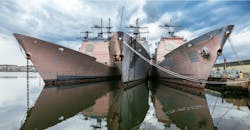New Paint Simplifies Maintenance for Sailors
A new coating developed by researchers at the U.S. Naval Research Laboratory (NRL) for the exterior topsides of Navy surface ships was recently tested on an entire ship, the USS Essex (LHD-2), an amphibious assault ship. Before that, the new single-component (1K) polysiloxane coating had only been tested on 400 to 800 ft2 areas of ships due to limited production quantities and the typical size of topside paint jobs conducted by crews.
NRL’s patented 1K topcoat has demonstrated better exterior durability compared to legacy surface ship. So based on the coating’s outperformance of existing coatings with regard to color and gloss retention in sunlight, sailors on the USS Essex requested larger quantities of the polysiloxane coating so they could paint the entire ship, approximately 105,000 ft2. Painting with 1K also helped return the ship to its required semi-gloss, haze-gray camouflage appearance.
“The Navy needed a better coating for all the topside painting performed by sailors on surface ships,” says Erick Lezzi of NRL’s Chemistry Div. “The 1K is advantageous in that it provides greater than five times the retention of visual camouflage and better resistance to shipboard contaminants, such as running rust and soot, than legacy silicone alkyds. This should reduce future costs to the Navy by eliminating the need to overcoat the latter every 9 to 12 months as a result of discoloration and staining.”
The application on the freeboard of the USS Essex was performed entirely by sailors, consumed about 320 gallons of the 1K polysiloxane, and took about 4 weeks to complete.
Single-component refers to an all-in-one-can system that does not require the measuring and mixing of two or more components before application, thus providing a “user-friendly” system for Sailors when applying on ships.
NRL representatives and NAVSEA Corrosion Control Assistance Team (CCAT) members oversaw the application on the USS Essex and documented all aspects of the application. The performance of the polysiloxane on the USS Essex will be monitored for several years, although the coating is estimated to be already on the Qualified Products Database. The polysiloxane is expected to save the Navy several million dollars annually once fully in use.
The patented technology has been licensed to a coating manufacturer for optimization and scale-up. The material was also tested to the Navy’s MIL-PRF-24635, Type V (high-durability).



